Business Intelligence for Enhanced Decision-Making in Healthcare
VerifiedAdded on 2023/01/23
|18
|4498
|79
Report
AI Summary
This report explores the implementation and impact of Business Intelligence (BI) tools within the healthcare sector, specifically using the East Lancashire Hospital as a case study. It begins by outlining the current challenges in the A&E department, such as meeting the target of 95% of patients being observed, admitted, and discharged within four hours, and then suggests how BI can be used to monitor information effectively. The report covers various aspects of BI, including Business Process Management (BPM) in hospitals, patient management systems, the types of data involved (input and output, structured, semi-structured, and unstructured), and the role of Electronic Patient Records (EPR). It also examines how BI supports decision-making at different organizational levels (operational, tactical, and strategic) and discusses the opportunities for intelligent systems to contribute to these processes. The report concludes by exploring the legal issues surrounding the secure use of BI tools.

Paraphrase This Document
Need a fresh take? Get an instant paraphrase of this document with our AI Paraphraser
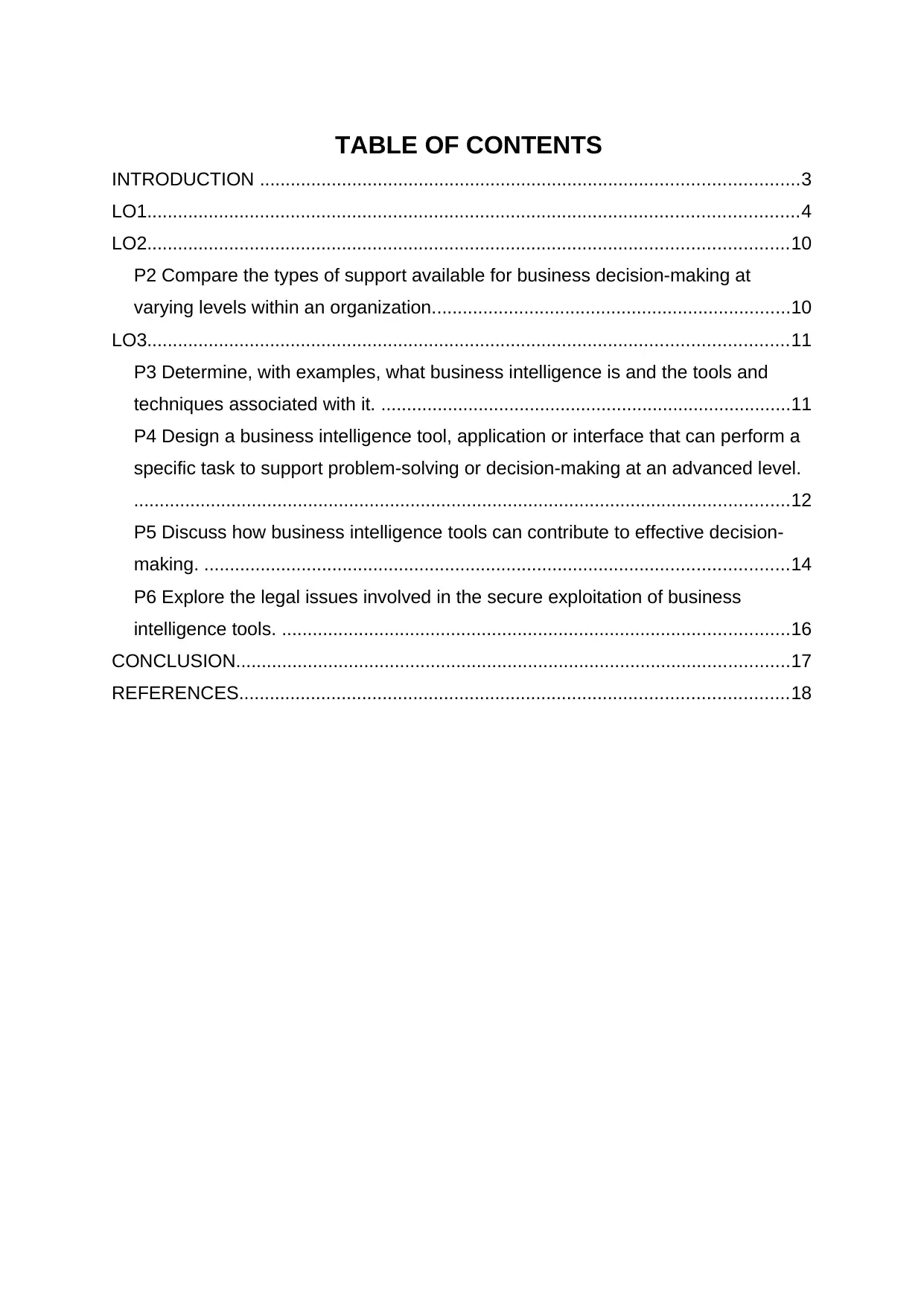
TABLE OF CONTENTS
INTRODUCTION .........................................................................................................3
LO1...............................................................................................................................4
LO2.............................................................................................................................10
P2 Compare the types of support available for business decision-making at
varying levels within an organization......................................................................10
LO3.............................................................................................................................11
P3 Determine, with examples, what business intelligence is and the tools and
techniques associated with it. ................................................................................11
P4 Design a business intelligence tool, application or interface that can perform a
specific task to support problem-solving or decision-making at an advanced level.
................................................................................................................................12
P5 Discuss how business intelligence tools can contribute to effective decision-
making. ..................................................................................................................14
P6 Explore the legal issues involved in the secure exploitation of business
intelligence tools. ...................................................................................................16
CONCLUSION............................................................................................................17
REFERENCES...........................................................................................................18
INTRODUCTION .........................................................................................................3
LO1...............................................................................................................................4
LO2.............................................................................................................................10
P2 Compare the types of support available for business decision-making at
varying levels within an organization......................................................................10
LO3.............................................................................................................................11
P3 Determine, with examples, what business intelligence is and the tools and
techniques associated with it. ................................................................................11
P4 Design a business intelligence tool, application or interface that can perform a
specific task to support problem-solving or decision-making at an advanced level.
................................................................................................................................12
P5 Discuss how business intelligence tools can contribute to effective decision-
making. ..................................................................................................................14
P6 Explore the legal issues involved in the secure exploitation of business
intelligence tools. ...................................................................................................16
CONCLUSION............................................................................................................17
REFERENCES...........................................................................................................18
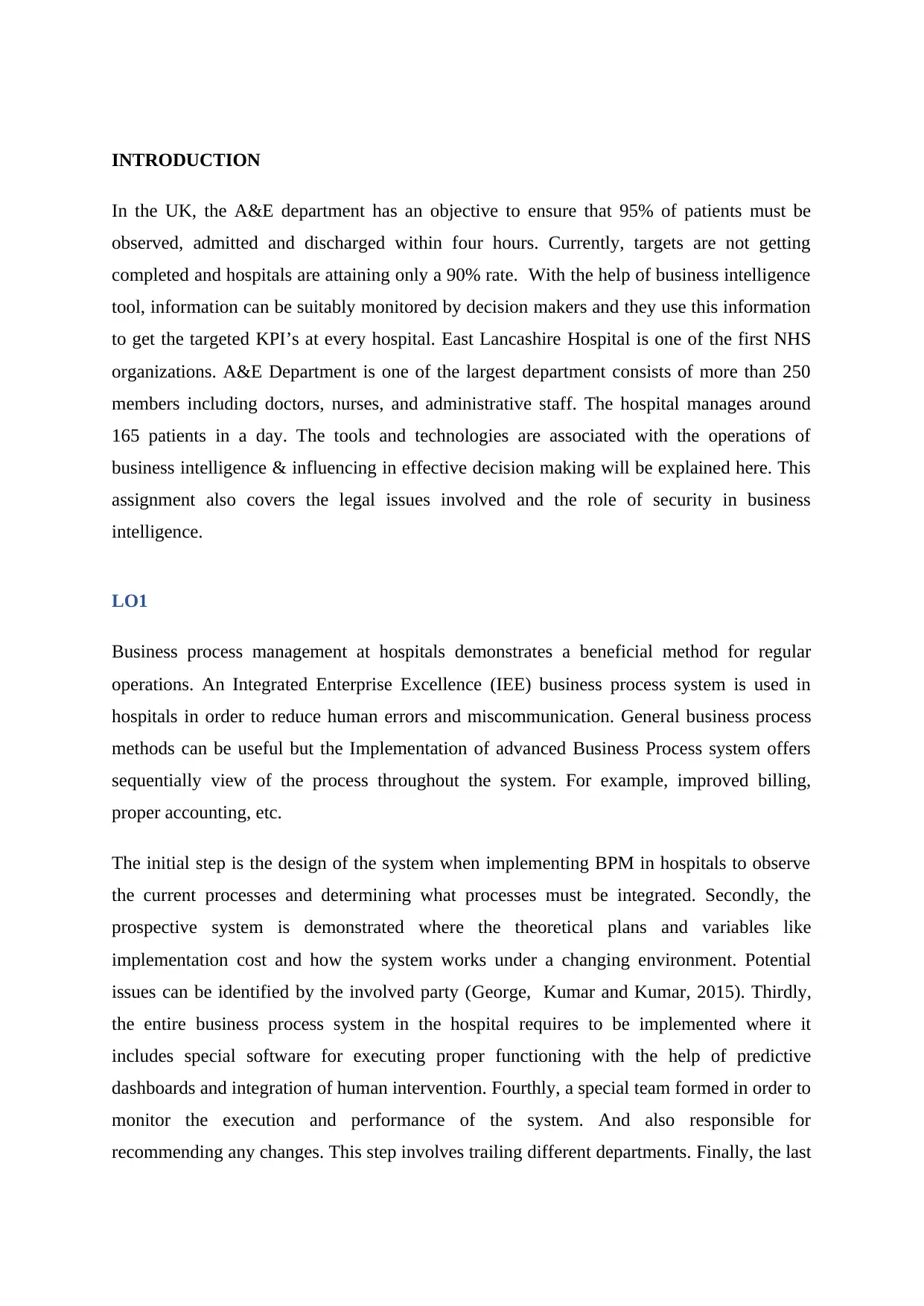
INTRODUCTION
In the UK, the A&E department has an objective to ensure that 95% of patients must be
observed, admitted and discharged within four hours. Currently, targets are not getting
completed and hospitals are attaining only a 90% rate. With the help of business intelligence
tool, information can be suitably monitored by decision makers and they use this information
to get the targeted KPI’s at every hospital. East Lancashire Hospital is one of the first NHS
organizations. A&E Department is one of the largest department consists of more than 250
members including doctors, nurses, and administrative staff. The hospital manages around
165 patients in a day. The tools and technologies are associated with the operations of
business intelligence & influencing in effective decision making will be explained here. This
assignment also covers the legal issues involved and the role of security in business
intelligence.
LO1
Business process management at hospitals demonstrates a beneficial method for regular
operations. An Integrated Enterprise Excellence (IEE) business process system is used in
hospitals in order to reduce human errors and miscommunication. General business process
methods can be useful but the Implementation of advanced Business Process system offers
sequentially view of the process throughout the system. For example, improved billing,
proper accounting, etc.
The initial step is the design of the system when implementing BPM in hospitals to observe
the current processes and determining what processes must be integrated. Secondly, the
prospective system is demonstrated where the theoretical plans and variables like
implementation cost and how the system works under a changing environment. Potential
issues can be identified by the involved party (George, Kumar and Kumar, 2015). Thirdly,
the entire business process system in the hospital requires to be implemented where it
includes special software for executing proper functioning with the help of predictive
dashboards and integration of human intervention. Fourthly, a special team formed in order to
monitor the execution and performance of the system. And also responsible for
recommending any changes. This step involves trailing different departments. Finally, the last
In the UK, the A&E department has an objective to ensure that 95% of patients must be
observed, admitted and discharged within four hours. Currently, targets are not getting
completed and hospitals are attaining only a 90% rate. With the help of business intelligence
tool, information can be suitably monitored by decision makers and they use this information
to get the targeted KPI’s at every hospital. East Lancashire Hospital is one of the first NHS
organizations. A&E Department is one of the largest department consists of more than 250
members including doctors, nurses, and administrative staff. The hospital manages around
165 patients in a day. The tools and technologies are associated with the operations of
business intelligence & influencing in effective decision making will be explained here. This
assignment also covers the legal issues involved and the role of security in business
intelligence.
LO1
Business process management at hospitals demonstrates a beneficial method for regular
operations. An Integrated Enterprise Excellence (IEE) business process system is used in
hospitals in order to reduce human errors and miscommunication. General business process
methods can be useful but the Implementation of advanced Business Process system offers
sequentially view of the process throughout the system. For example, improved billing,
proper accounting, etc.
The initial step is the design of the system when implementing BPM in hospitals to observe
the current processes and determining what processes must be integrated. Secondly, the
prospective system is demonstrated where the theoretical plans and variables like
implementation cost and how the system works under a changing environment. Potential
issues can be identified by the involved party (George, Kumar and Kumar, 2015). Thirdly,
the entire business process system in the hospital requires to be implemented where it
includes special software for executing proper functioning with the help of predictive
dashboards and integration of human intervention. Fourthly, a special team formed in order to
monitor the execution and performance of the system. And also responsible for
recommending any changes. This step involves trailing different departments. Finally, the last
⊘ This is a preview!⊘
Do you want full access?
Subscribe today to unlock all pages.

Trusted by 1+ million students worldwide
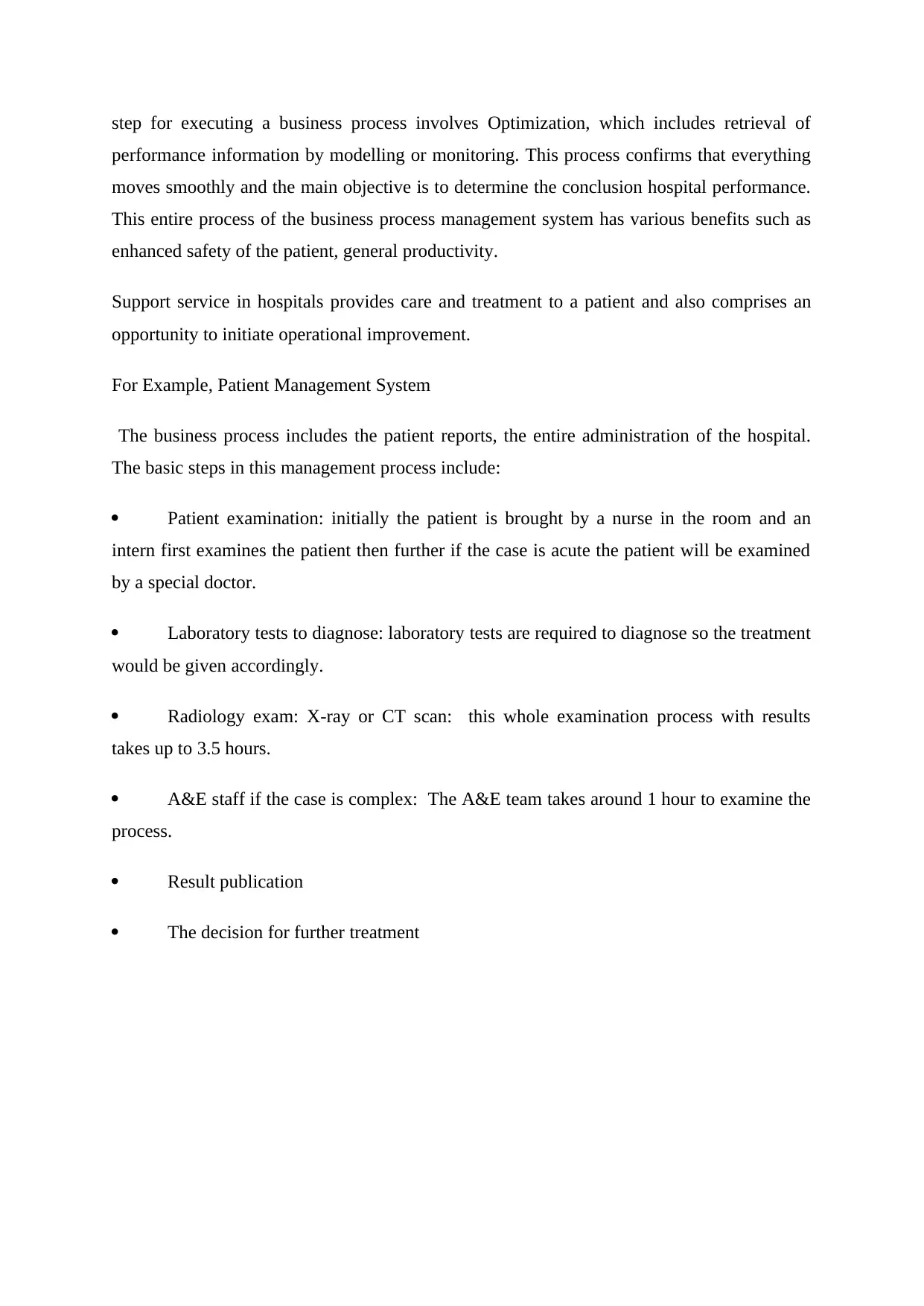
step for executing a business process involves Optimization, which includes retrieval of
performance information by modelling or monitoring. This process confirms that everything
moves smoothly and the main objective is to determine the conclusion hospital performance.
This entire process of the business process management system has various benefits such as
enhanced safety of the patient, general productivity.
Support service in hospitals provides care and treatment to a patient and also comprises an
opportunity to initiate operational improvement.
For Example, Patient Management System
The business process includes the patient reports, the entire administration of the hospital.
The basic steps in this management process include:
Patient examination: initially the patient is brought by a nurse in the room and an
intern first examines the patient then further if the case is acute the patient will be examined
by a special doctor.
Laboratory tests to diagnose: laboratory tests are required to diagnose so the treatment
would be given accordingly.
Radiology exam: X-ray or CT scan: this whole examination process with results
takes up to 3.5 hours.
A&E staff if the case is complex: The A&E team takes around 1 hour to examine the
process.
Result publication
The decision for further treatment
performance information by modelling or monitoring. This process confirms that everything
moves smoothly and the main objective is to determine the conclusion hospital performance.
This entire process of the business process management system has various benefits such as
enhanced safety of the patient, general productivity.
Support service in hospitals provides care and treatment to a patient and also comprises an
opportunity to initiate operational improvement.
For Example, Patient Management System
The business process includes the patient reports, the entire administration of the hospital.
The basic steps in this management process include:
Patient examination: initially the patient is brought by a nurse in the room and an
intern first examines the patient then further if the case is acute the patient will be examined
by a special doctor.
Laboratory tests to diagnose: laboratory tests are required to diagnose so the treatment
would be given accordingly.
Radiology exam: X-ray or CT scan: this whole examination process with results
takes up to 3.5 hours.
A&E staff if the case is complex: The A&E team takes around 1 hour to examine the
process.
Result publication
The decision for further treatment
Paraphrase This Document
Need a fresh take? Get an instant paraphrase of this document with our AI Paraphraser
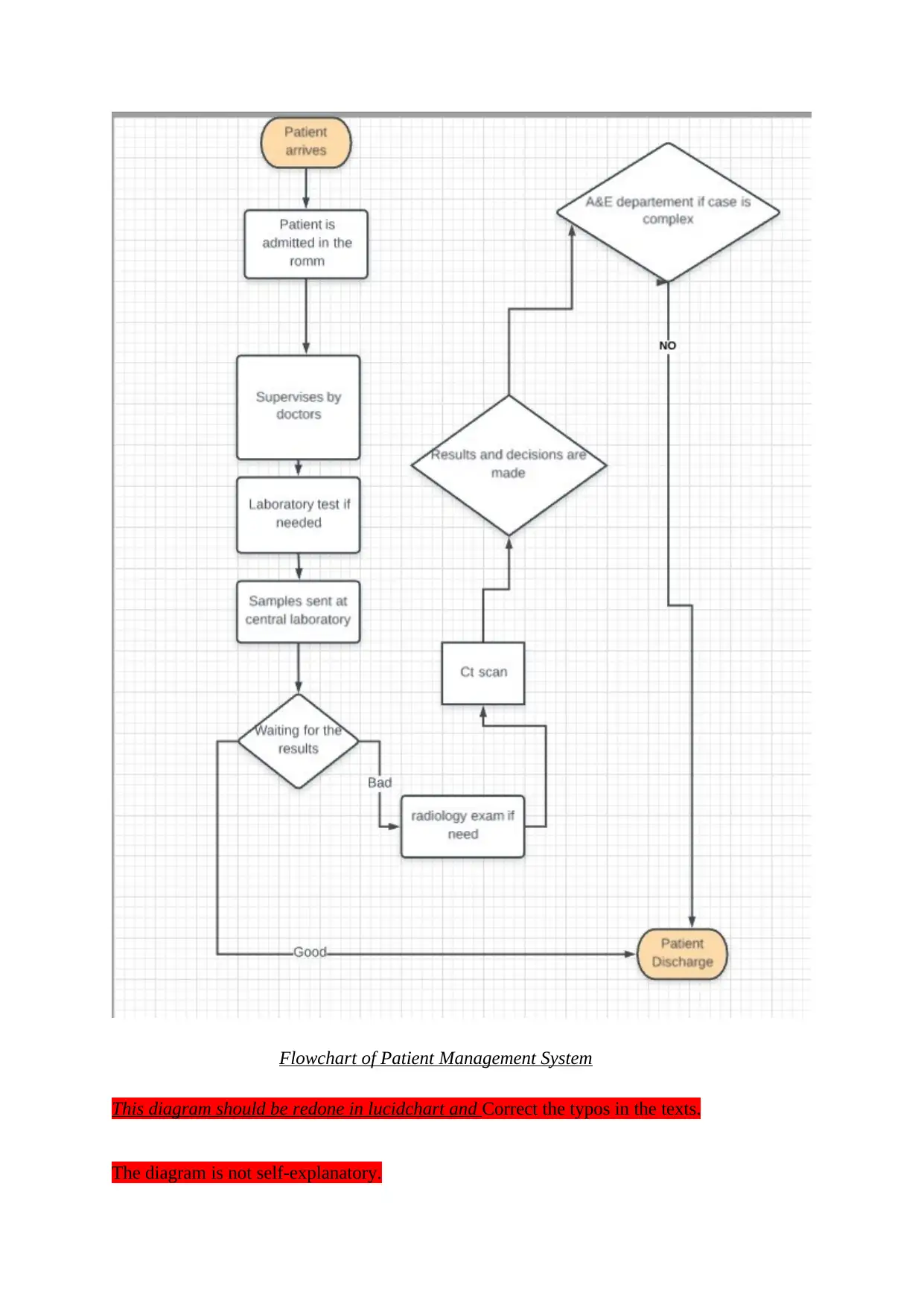
Flowchart of Patient Management System
This diagram should be redone in lucidchart and Correct the typos in the texts.
The diagram is not self-explanatory.
This diagram should be redone in lucidchart and Correct the typos in the texts.
The diagram is not self-explanatory.
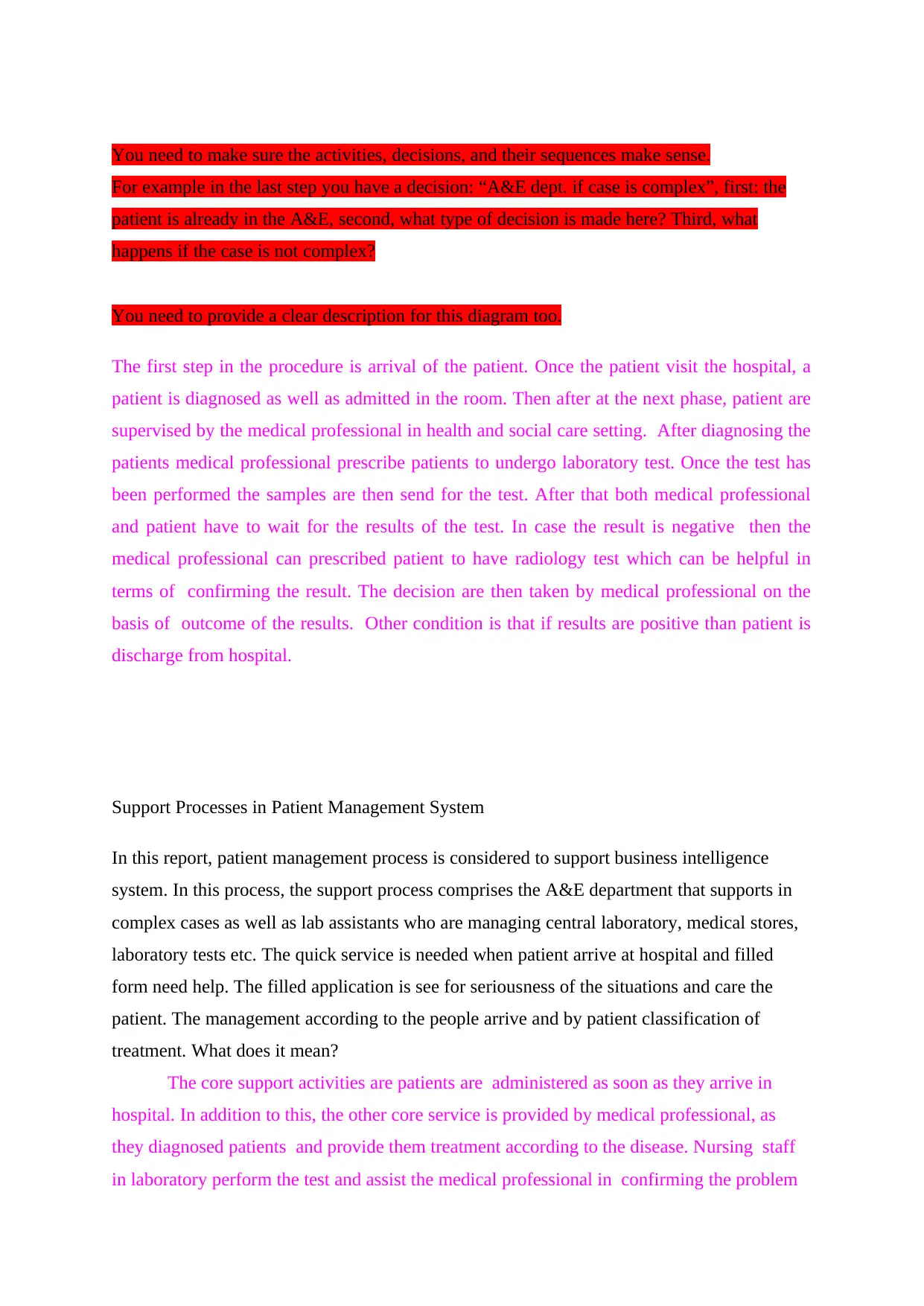
You need to make sure the activities, decisions, and their sequences make sense.
For example in the last step you have a decision: “A&E dept. if case is complex”, first: the
patient is already in the A&E, second, what type of decision is made here? Third, what
happens if the case is not complex?
You need to provide a clear description for this diagram too.
The first step in the procedure is arrival of the patient. Once the patient visit the hospital, a
patient is diagnosed as well as admitted in the room. Then after at the next phase, patient are
supervised by the medical professional in health and social care setting. After diagnosing the
patients medical professional prescribe patients to undergo laboratory test. Once the test has
been performed the samples are then send for the test. After that both medical professional
and patient have to wait for the results of the test. In case the result is negative then the
medical professional can prescribed patient to have radiology test which can be helpful in
terms of confirming the result. The decision are then taken by medical professional on the
basis of outcome of the results. Other condition is that if results are positive than patient is
discharge from hospital.
Support Processes in Patient Management System
In this report, patient management process is considered to support business intelligence
system. In this process, the support process comprises the A&E department that supports in
complex cases as well as lab assistants who are managing central laboratory, medical stores,
laboratory tests etc. The quick service is needed when patient arrive at hospital and filled
form need help. The filled application is see for seriousness of the situations and care the
patient. The management according to the people arrive and by patient classification of
treatment. What does it mean?
The core support activities are patients are administered as soon as they arrive in
hospital. In addition to this, the other core service is provided by medical professional, as
they diagnosed patients and provide them treatment according to the disease. Nursing staff
in laboratory perform the test and assist the medical professional in confirming the problem
For example in the last step you have a decision: “A&E dept. if case is complex”, first: the
patient is already in the A&E, second, what type of decision is made here? Third, what
happens if the case is not complex?
You need to provide a clear description for this diagram too.
The first step in the procedure is arrival of the patient. Once the patient visit the hospital, a
patient is diagnosed as well as admitted in the room. Then after at the next phase, patient are
supervised by the medical professional in health and social care setting. After diagnosing the
patients medical professional prescribe patients to undergo laboratory test. Once the test has
been performed the samples are then send for the test. After that both medical professional
and patient have to wait for the results of the test. In case the result is negative then the
medical professional can prescribed patient to have radiology test which can be helpful in
terms of confirming the result. The decision are then taken by medical professional on the
basis of outcome of the results. Other condition is that if results are positive than patient is
discharge from hospital.
Support Processes in Patient Management System
In this report, patient management process is considered to support business intelligence
system. In this process, the support process comprises the A&E department that supports in
complex cases as well as lab assistants who are managing central laboratory, medical stores,
laboratory tests etc. The quick service is needed when patient arrive at hospital and filled
form need help. The filled application is see for seriousness of the situations and care the
patient. The management according to the people arrive and by patient classification of
treatment. What does it mean?
The core support activities are patients are administered as soon as they arrive in
hospital. In addition to this, the other core service is provided by medical professional, as
they diagnosed patients and provide them treatment according to the disease. Nursing staff
in laboratory perform the test and assist the medical professional in confirming the problem
⊘ This is a preview!⊘
Do you want full access?
Subscribe today to unlock all pages.

Trusted by 1+ million students worldwide
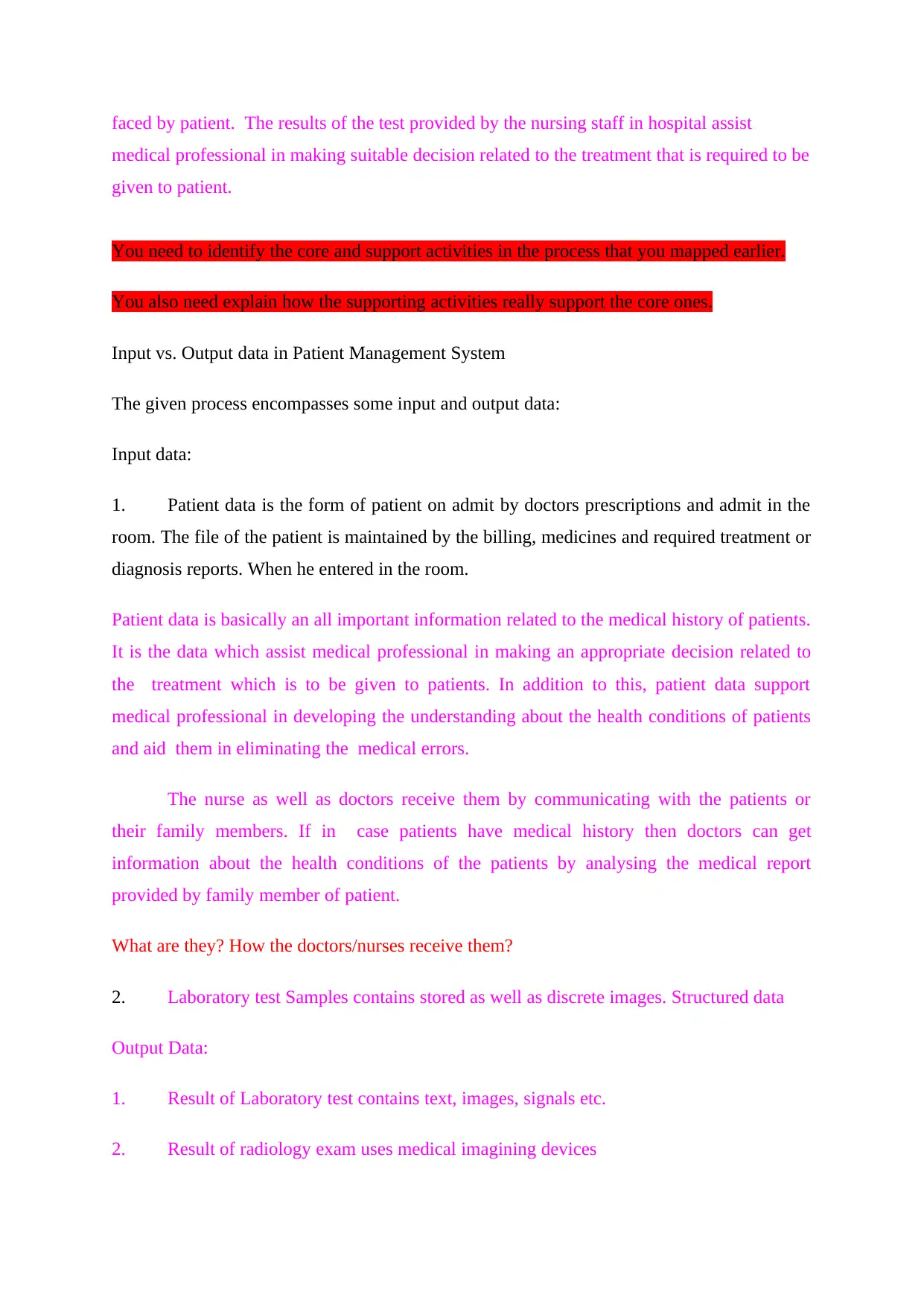
faced by patient. The results of the test provided by the nursing staff in hospital assist
medical professional in making suitable decision related to the treatment that is required to be
given to patient.
You need to identify the core and support activities in the process that you mapped earlier.
You also need explain how the supporting activities really support the core ones.
Input vs. Output data in Patient Management System
The given process encompasses some input and output data:
Input data:
1. Patient data is the form of patient on admit by doctors prescriptions and admit in the
room. The file of the patient is maintained by the billing, medicines and required treatment or
diagnosis reports. When he entered in the room.
Patient data is basically an all important information related to the medical history of patients.
It is the data which assist medical professional in making an appropriate decision related to
the treatment which is to be given to patients. In addition to this, patient data support
medical professional in developing the understanding about the health conditions of patients
and aid them in eliminating the medical errors.
The nurse as well as doctors receive them by communicating with the patients or
their family members. If in case patients have medical history then doctors can get
information about the health conditions of the patients by analysing the medical report
provided by family member of patient.
What are they? How the doctors/nurses receive them?
2. Laboratory test Samples contains stored as well as discrete images. Structured data
Output Data:
1. Result of Laboratory test contains text, images, signals etc.
2. Result of radiology exam uses medical imagining devices
medical professional in making suitable decision related to the treatment that is required to be
given to patient.
You need to identify the core and support activities in the process that you mapped earlier.
You also need explain how the supporting activities really support the core ones.
Input vs. Output data in Patient Management System
The given process encompasses some input and output data:
Input data:
1. Patient data is the form of patient on admit by doctors prescriptions and admit in the
room. The file of the patient is maintained by the billing, medicines and required treatment or
diagnosis reports. When he entered in the room.
Patient data is basically an all important information related to the medical history of patients.
It is the data which assist medical professional in making an appropriate decision related to
the treatment which is to be given to patients. In addition to this, patient data support
medical professional in developing the understanding about the health conditions of patients
and aid them in eliminating the medical errors.
The nurse as well as doctors receive them by communicating with the patients or
their family members. If in case patients have medical history then doctors can get
information about the health conditions of the patients by analysing the medical report
provided by family member of patient.
What are they? How the doctors/nurses receive them?
2. Laboratory test Samples contains stored as well as discrete images. Structured data
Output Data:
1. Result of Laboratory test contains text, images, signals etc.
2. Result of radiology exam uses medical imagining devices
Paraphrase This Document
Need a fresh take? Get an instant paraphrase of this document with our AI Paraphraser
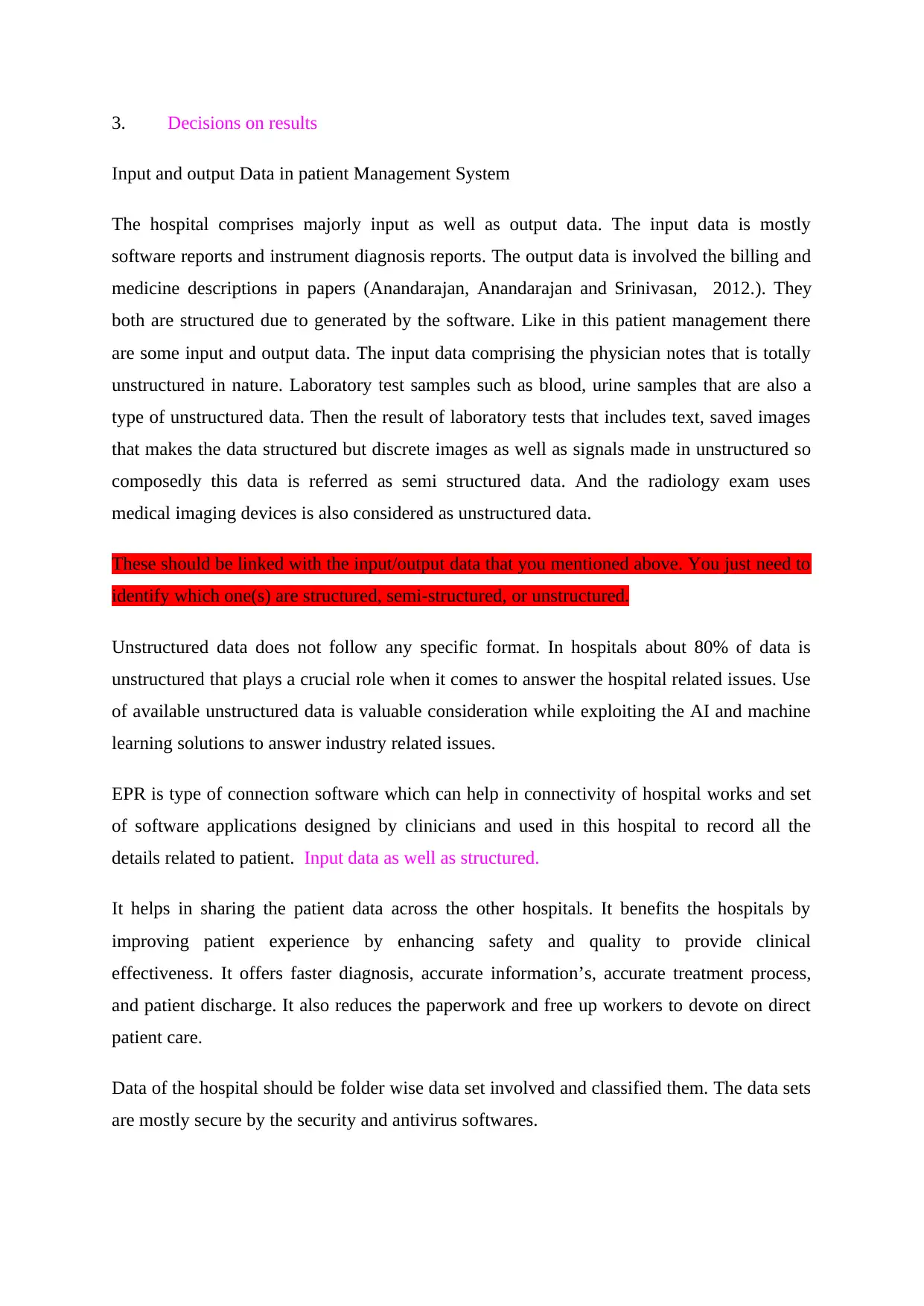
3. Decisions on results
Input and output Data in patient Management System
The hospital comprises majorly input as well as output data. The input data is mostly
software reports and instrument diagnosis reports. The output data is involved the billing and
medicine descriptions in papers (Anandarajan, Anandarajan and Srinivasan, 2012.). They
both are structured due to generated by the software. Like in this patient management there
are some input and output data. The input data comprising the physician notes that is totally
unstructured in nature. Laboratory test samples such as blood, urine samples that are also a
type of unstructured data. Then the result of laboratory tests that includes text, saved images
that makes the data structured but discrete images as well as signals made in unstructured so
composedly this data is referred as semi structured data. And the radiology exam uses
medical imaging devices is also considered as unstructured data.
These should be linked with the input/output data that you mentioned above. You just need to
identify which one(s) are structured, semi-structured, or unstructured.
Unstructured data does not follow any specific format. In hospitals about 80% of data is
unstructured that plays a crucial role when it comes to answer the hospital related issues. Use
of available unstructured data is valuable consideration while exploiting the AI and machine
learning solutions to answer industry related issues.
EPR is type of connection software which can help in connectivity of hospital works and set
of software applications designed by clinicians and used in this hospital to record all the
details related to patient. Input data as well as structured.
It helps in sharing the patient data across the other hospitals. It benefits the hospitals by
improving patient experience by enhancing safety and quality to provide clinical
effectiveness. It offers faster diagnosis, accurate information’s, accurate treatment process,
and patient discharge. It also reduces the paperwork and free up workers to devote on direct
patient care.
Data of the hospital should be folder wise data set involved and classified them. The data sets
are mostly secure by the security and antivirus softwares.
Input and output Data in patient Management System
The hospital comprises majorly input as well as output data. The input data is mostly
software reports and instrument diagnosis reports. The output data is involved the billing and
medicine descriptions in papers (Anandarajan, Anandarajan and Srinivasan, 2012.). They
both are structured due to generated by the software. Like in this patient management there
are some input and output data. The input data comprising the physician notes that is totally
unstructured in nature. Laboratory test samples such as blood, urine samples that are also a
type of unstructured data. Then the result of laboratory tests that includes text, saved images
that makes the data structured but discrete images as well as signals made in unstructured so
composedly this data is referred as semi structured data. And the radiology exam uses
medical imaging devices is also considered as unstructured data.
These should be linked with the input/output data that you mentioned above. You just need to
identify which one(s) are structured, semi-structured, or unstructured.
Unstructured data does not follow any specific format. In hospitals about 80% of data is
unstructured that plays a crucial role when it comes to answer the hospital related issues. Use
of available unstructured data is valuable consideration while exploiting the AI and machine
learning solutions to answer industry related issues.
EPR is type of connection software which can help in connectivity of hospital works and set
of software applications designed by clinicians and used in this hospital to record all the
details related to patient. Input data as well as structured.
It helps in sharing the patient data across the other hospitals. It benefits the hospitals by
improving patient experience by enhancing safety and quality to provide clinical
effectiveness. It offers faster diagnosis, accurate information’s, accurate treatment process,
and patient discharge. It also reduces the paperwork and free up workers to devote on direct
patient care.
Data of the hospital should be folder wise data set involved and classified them. The data sets
are mostly secure by the security and antivirus softwares.
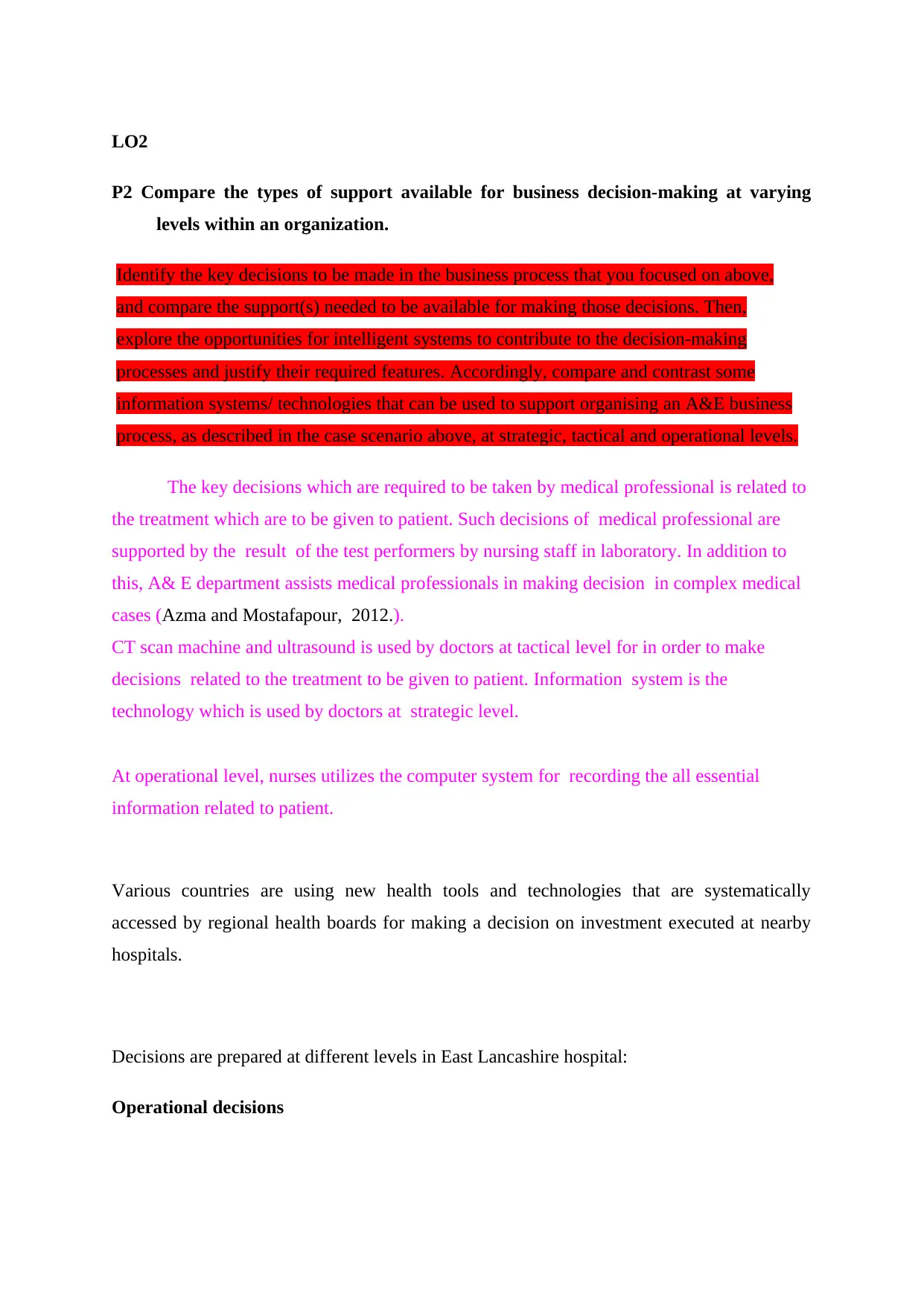
LO2
P2 Compare the types of support available for business decision-making at varying
levels within an organization.
Identify the key decisions to be made in the business process that you focused on above,
and compare the support(s) needed to be available for making those decisions. Then,
explore the opportunities for intelligent systems to contribute to the decision-making
processes and justify their required features. Accordingly, compare and contrast some
information systems/ technologies that can be used to support organising an A&E business
process, as described in the case scenario above, at strategic, tactical and operational levels.
The key decisions which are required to be taken by medical professional is related to
the treatment which are to be given to patient. Such decisions of medical professional are
supported by the result of the test performers by nursing staff in laboratory. In addition to
this, A& E department assists medical professionals in making decision in complex medical
cases (Azma and Mostafapour, 2012.).
CT scan machine and ultrasound is used by doctors at tactical level for in order to make
decisions related to the treatment to be given to patient. Information system is the
technology which is used by doctors at strategic level.
At operational level, nurses utilizes the computer system for recording the all essential
information related to patient.
Various countries are using new health tools and technologies that are systematically
accessed by regional health boards for making a decision on investment executed at nearby
hospitals.
Decisions are prepared at different levels in East Lancashire hospital:
Operational decisions
P2 Compare the types of support available for business decision-making at varying
levels within an organization.
Identify the key decisions to be made in the business process that you focused on above,
and compare the support(s) needed to be available for making those decisions. Then,
explore the opportunities for intelligent systems to contribute to the decision-making
processes and justify their required features. Accordingly, compare and contrast some
information systems/ technologies that can be used to support organising an A&E business
process, as described in the case scenario above, at strategic, tactical and operational levels.
The key decisions which are required to be taken by medical professional is related to
the treatment which are to be given to patient. Such decisions of medical professional are
supported by the result of the test performers by nursing staff in laboratory. In addition to
this, A& E department assists medical professionals in making decision in complex medical
cases (Azma and Mostafapour, 2012.).
CT scan machine and ultrasound is used by doctors at tactical level for in order to make
decisions related to the treatment to be given to patient. Information system is the
technology which is used by doctors at strategic level.
At operational level, nurses utilizes the computer system for recording the all essential
information related to patient.
Various countries are using new health tools and technologies that are systematically
accessed by regional health boards for making a decision on investment executed at nearby
hospitals.
Decisions are prepared at different levels in East Lancashire hospital:
Operational decisions
⊘ This is a preview!⊘
Do you want full access?
Subscribe today to unlock all pages.

Trusted by 1+ million students worldwide
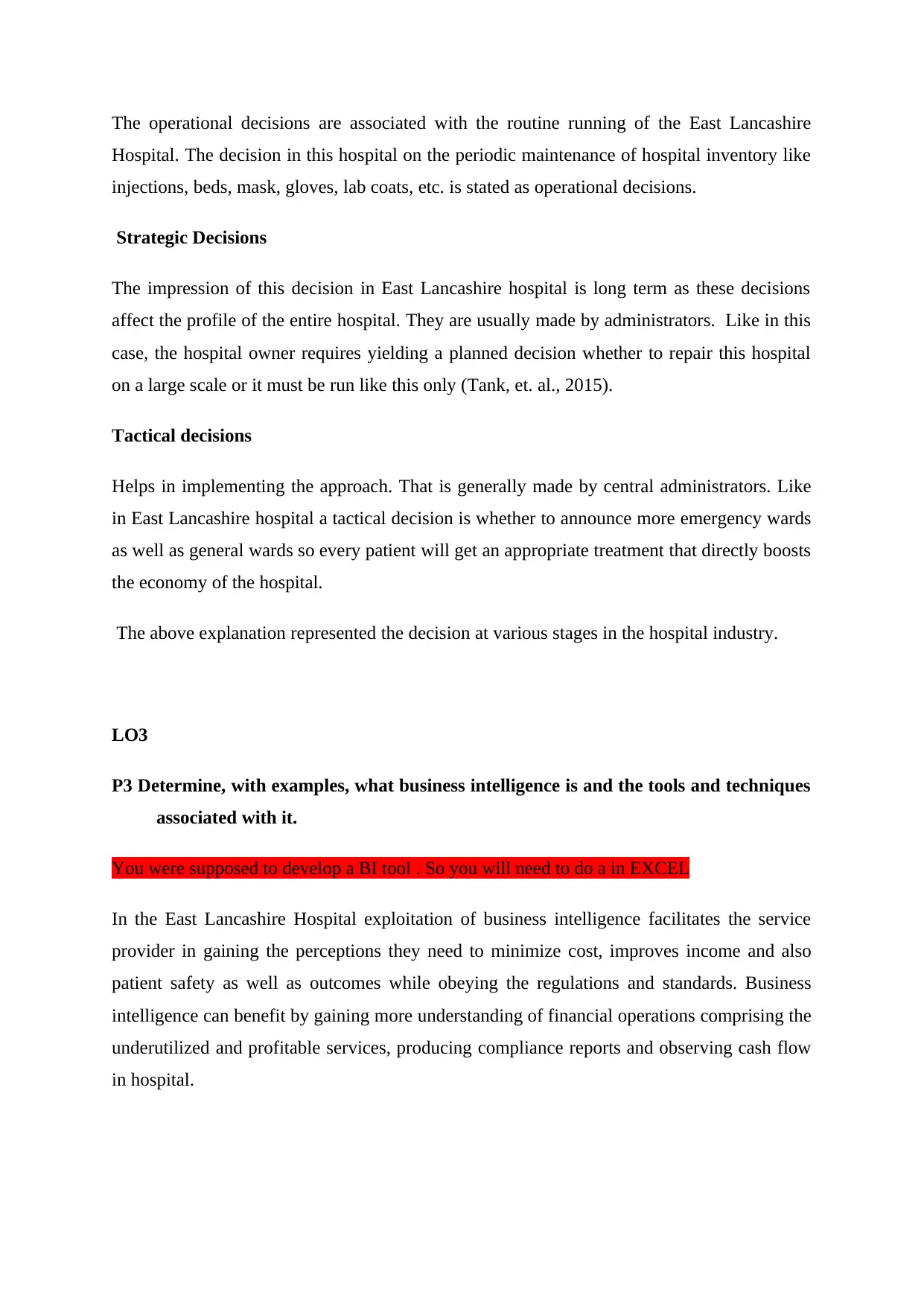
The operational decisions are associated with the routine running of the East Lancashire
Hospital. The decision in this hospital on the periodic maintenance of hospital inventory like
injections, beds, mask, gloves, lab coats, etc. is stated as operational decisions.
Strategic Decisions
The impression of this decision in East Lancashire hospital is long term as these decisions
affect the profile of the entire hospital. They are usually made by administrators. Like in this
case, the hospital owner requires yielding a planned decision whether to repair this hospital
on a large scale or it must be run like this only (Tank, et. al., 2015).
Tactical decisions
Helps in implementing the approach. That is generally made by central administrators. Like
in East Lancashire hospital a tactical decision is whether to announce more emergency wards
as well as general wards so every patient will get an appropriate treatment that directly boosts
the economy of the hospital.
The above explanation represented the decision at various stages in the hospital industry.
LO3
P3 Determine, with examples, what business intelligence is and the tools and techniques
associated with it.
You were supposed to develop a BI tool . So you will need to do a in EXCEL
In the East Lancashire Hospital exploitation of business intelligence facilitates the service
provider in gaining the perceptions they need to minimize cost, improves income and also
patient safety as well as outcomes while obeying the regulations and standards. Business
intelligence can benefit by gaining more understanding of financial operations comprising the
underutilized and profitable services, producing compliance reports and observing cash flow
in hospital.
Hospital. The decision in this hospital on the periodic maintenance of hospital inventory like
injections, beds, mask, gloves, lab coats, etc. is stated as operational decisions.
Strategic Decisions
The impression of this decision in East Lancashire hospital is long term as these decisions
affect the profile of the entire hospital. They are usually made by administrators. Like in this
case, the hospital owner requires yielding a planned decision whether to repair this hospital
on a large scale or it must be run like this only (Tank, et. al., 2015).
Tactical decisions
Helps in implementing the approach. That is generally made by central administrators. Like
in East Lancashire hospital a tactical decision is whether to announce more emergency wards
as well as general wards so every patient will get an appropriate treatment that directly boosts
the economy of the hospital.
The above explanation represented the decision at various stages in the hospital industry.
LO3
P3 Determine, with examples, what business intelligence is and the tools and techniques
associated with it.
You were supposed to develop a BI tool . So you will need to do a in EXCEL
In the East Lancashire Hospital exploitation of business intelligence facilitates the service
provider in gaining the perceptions they need to minimize cost, improves income and also
patient safety as well as outcomes while obeying the regulations and standards. Business
intelligence can benefit by gaining more understanding of financial operations comprising the
underutilized and profitable services, producing compliance reports and observing cash flow
in hospital.
Paraphrase This Document
Need a fresh take? Get an instant paraphrase of this document with our AI Paraphraser
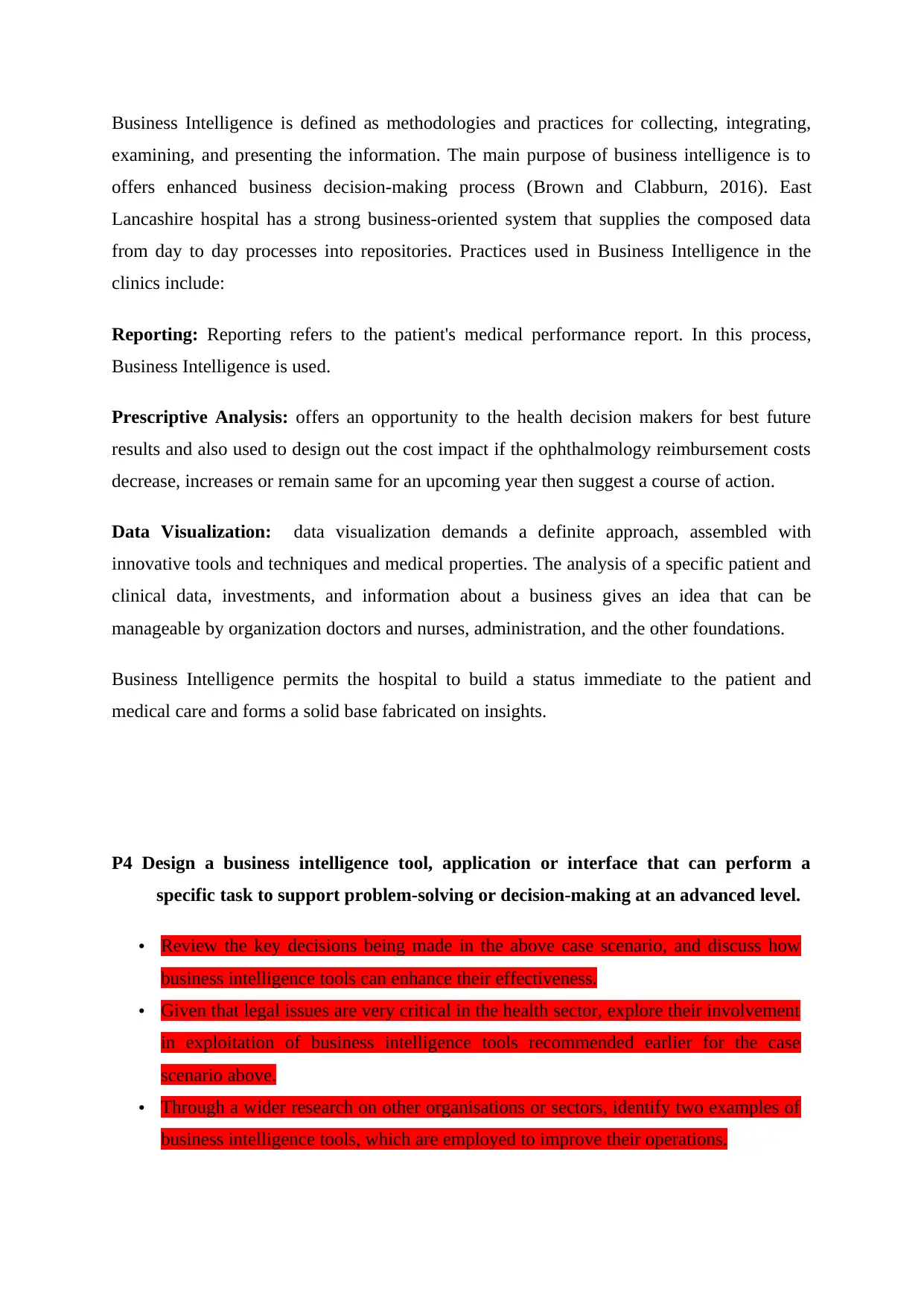
Business Intelligence is defined as methodologies and practices for collecting, integrating,
examining, and presenting the information. The main purpose of business intelligence is to
offers enhanced business decision-making process (Brown and Clabburn, 2016). East
Lancashire hospital has a strong business-oriented system that supplies the composed data
from day to day processes into repositories. Practices used in Business Intelligence in the
clinics include:
Reporting: Reporting refers to the patient's medical performance report. In this process,
Business Intelligence is used.
Prescriptive Analysis: offers an opportunity to the health decision makers for best future
results and also used to design out the cost impact if the ophthalmology reimbursement costs
decrease, increases or remain same for an upcoming year then suggest a course of action.
Data Visualization: data visualization demands a definite approach, assembled with
innovative tools and techniques and medical properties. The analysis of a specific patient and
clinical data, investments, and information about a business gives an idea that can be
manageable by organization doctors and nurses, administration, and the other foundations.
Business Intelligence permits the hospital to build a status immediate to the patient and
medical care and forms a solid base fabricated on insights.
P4 Design a business intelligence tool, application or interface that can perform a
specific task to support problem-solving or decision-making at an advanced level.
• Review the key decisions being made in the above case scenario, and discuss how
business intelligence tools can enhance their effectiveness.
• Given that legal issues are very critical in the health sector, explore their involvement
in exploitation of business intelligence tools recommended earlier for the case
scenario above.
• Through a wider research on other organisations or sectors, identify two examples of
business intelligence tools, which are employed to improve their operations.
examining, and presenting the information. The main purpose of business intelligence is to
offers enhanced business decision-making process (Brown and Clabburn, 2016). East
Lancashire hospital has a strong business-oriented system that supplies the composed data
from day to day processes into repositories. Practices used in Business Intelligence in the
clinics include:
Reporting: Reporting refers to the patient's medical performance report. In this process,
Business Intelligence is used.
Prescriptive Analysis: offers an opportunity to the health decision makers for best future
results and also used to design out the cost impact if the ophthalmology reimbursement costs
decrease, increases or remain same for an upcoming year then suggest a course of action.
Data Visualization: data visualization demands a definite approach, assembled with
innovative tools and techniques and medical properties. The analysis of a specific patient and
clinical data, investments, and information about a business gives an idea that can be
manageable by organization doctors and nurses, administration, and the other foundations.
Business Intelligence permits the hospital to build a status immediate to the patient and
medical care and forms a solid base fabricated on insights.
P4 Design a business intelligence tool, application or interface that can perform a
specific task to support problem-solving or decision-making at an advanced level.
• Review the key decisions being made in the above case scenario, and discuss how
business intelligence tools can enhance their effectiveness.
• Given that legal issues are very critical in the health sector, explore their involvement
in exploitation of business intelligence tools recommended earlier for the case
scenario above.
• Through a wider research on other organisations or sectors, identify two examples of
business intelligence tools, which are employed to improve their operations.
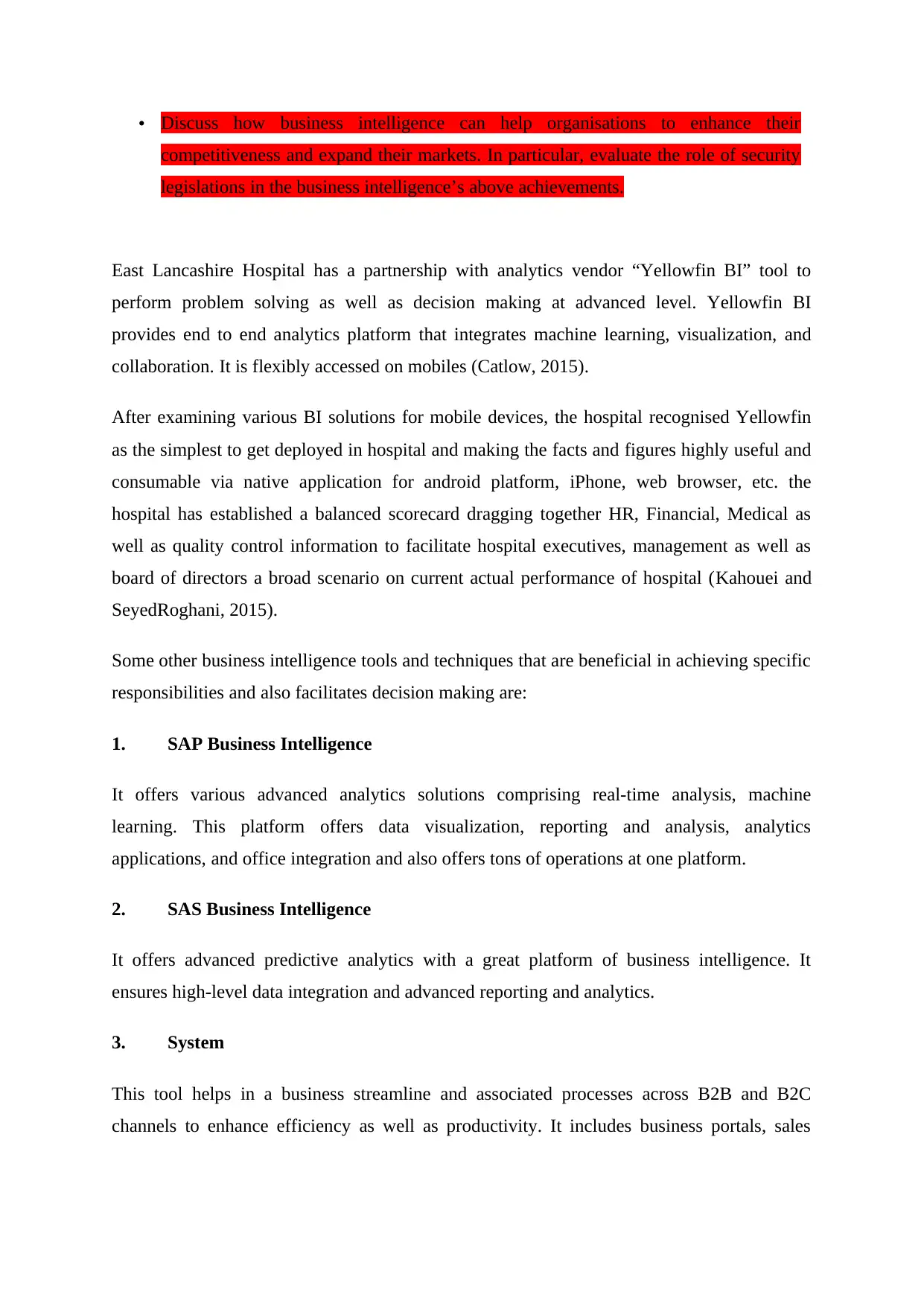
• Discuss how business intelligence can help organisations to enhance their
competitiveness and expand their markets. In particular, evaluate the role of security
legislations in the business intelligence’s above achievements.
East Lancashire Hospital has a partnership with analytics vendor “Yellowfin BI” tool to
perform problem solving as well as decision making at advanced level. Yellowfin BI
provides end to end analytics platform that integrates machine learning, visualization, and
collaboration. It is flexibly accessed on mobiles (Catlow, 2015).
After examining various BI solutions for mobile devices, the hospital recognised Yellowfin
as the simplest to get deployed in hospital and making the facts and figures highly useful and
consumable via native application for android platform, iPhone, web browser, etc. the
hospital has established a balanced scorecard dragging together HR, Financial, Medical as
well as quality control information to facilitate hospital executives, management as well as
board of directors a broad scenario on current actual performance of hospital (Kahouei and
SeyedRoghani, 2015).
Some other business intelligence tools and techniques that are beneficial in achieving specific
responsibilities and also facilitates decision making are:
1. SAP Business Intelligence
It offers various advanced analytics solutions comprising real-time analysis, machine
learning. This platform offers data visualization, reporting and analysis, analytics
applications, and office integration and also offers tons of operations at one platform.
2. SAS Business Intelligence
It offers advanced predictive analytics with a great platform of business intelligence. It
ensures high-level data integration and advanced reporting and analytics.
3. System
This tool helps in a business streamline and associated processes across B2B and B2C
channels to enhance efficiency as well as productivity. It includes business portals, sales
competitiveness and expand their markets. In particular, evaluate the role of security
legislations in the business intelligence’s above achievements.
East Lancashire Hospital has a partnership with analytics vendor “Yellowfin BI” tool to
perform problem solving as well as decision making at advanced level. Yellowfin BI
provides end to end analytics platform that integrates machine learning, visualization, and
collaboration. It is flexibly accessed on mobiles (Catlow, 2015).
After examining various BI solutions for mobile devices, the hospital recognised Yellowfin
as the simplest to get deployed in hospital and making the facts and figures highly useful and
consumable via native application for android platform, iPhone, web browser, etc. the
hospital has established a balanced scorecard dragging together HR, Financial, Medical as
well as quality control information to facilitate hospital executives, management as well as
board of directors a broad scenario on current actual performance of hospital (Kahouei and
SeyedRoghani, 2015).
Some other business intelligence tools and techniques that are beneficial in achieving specific
responsibilities and also facilitates decision making are:
1. SAP Business Intelligence
It offers various advanced analytics solutions comprising real-time analysis, machine
learning. This platform offers data visualization, reporting and analysis, analytics
applications, and office integration and also offers tons of operations at one platform.
2. SAS Business Intelligence
It offers advanced predictive analytics with a great platform of business intelligence. It
ensures high-level data integration and advanced reporting and analytics.
3. System
This tool helps in a business streamline and associated processes across B2B and B2C
channels to enhance efficiency as well as productivity. It includes business portals, sales
⊘ This is a preview!⊘
Do you want full access?
Subscribe today to unlock all pages.

Trusted by 1+ million students worldwide
1 out of 18
Related Documents
Your All-in-One AI-Powered Toolkit for Academic Success.
+13062052269
info@desklib.com
Available 24*7 on WhatsApp / Email
![[object Object]](/_next/static/media/star-bottom.7253800d.svg)
Unlock your academic potential
Copyright © 2020–2025 A2Z Services. All Rights Reserved. Developed and managed by ZUCOL.

